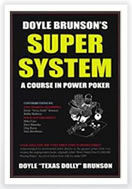 |
Author: Doyle Brunson Publisher: Cardoza Publishing Pages: 605 Pub. Date: 2002 (3rd Edition) Price: $19.77 |
Book Review: Part 2
From there it’s on to Mike Caro’s section on draw poker, perhaps the most dated section of the book. Many purchasers of Super/System will skip over this section, despite some good general knowledge on hand selection, computing odds and probabilities, and table image. From there Super/System moves on to a solid seven-card stud section by a very young Chip Reese. Reese was a recent arrival from Ohio, but had already stamped himself as a master of the stud game, and the forty-plus pages Reese served up remain among the best stud primers ever written. Starting hand selections, made hands, drawing hands, and street-by-street lessons on how to outplay one’s opponents make this one a keeper.
Next up is the section on lowball poker by Joey Hawthorne, which also remains of value today. Subjectively, lowball remains one of the games played worst by most online players (where it can often be found), and with a bit of reading and practice, one can quickly become competitive well above micro stakes. Hawthorne specialized in ace-to-five lowball, though his work is easily translated to the deuce-to-seven “Kansas City” format, which may well be more popular today. Hawthorne also includes several pages on razz, which remains in widespread play through its inclusion in H.O.R.S.E. formats.
David Sklansky’s work on seven-card stud high/low comes next, serving up a heavily math-based and logical approach to that game. Sklansky focuses first on proper starting hand selections – which vary according to other players’ up cards and how they’re bet – and the importance of honing in on “scoopable” pots, which is where the game’s profit lies. After that it’s on to topics such as protection, the two-way power of aces, and a street-by-street discussion of proper play. The section wraps up with a few pages on other variants, such as high/low declare, which these days is seldom found outside of home games.
Finally, Super/System moves on to the land of hold ‘em. First comes Bobby Baldwin’s section on fixed-limit play, with its focus on hand selections, table position, and proper betting strategies. Baldwin touches on most of limit’s core concepts, including the playing of overpairs, trips and flopped sets, understanding pot odds and recognizing dangerous flops, and reading both opponents and the bets they make in certain spots.
No-limit hold ‘em, of course, is the biggest single offering of Super/System, and Doyle Brunson’s meaty section on the topic closes the book in force. Brunson’s “introduction” to the topic actually chews up a third of this section’s length and discusses many important topics, such as aggression, playing draws, when to bet into the opening leader, reading hands and flops, categorizing other players, tilt control and much more. After that, Brunson moves on to a step-by-step discussion of how to play certain holdings, beginning with pocket aces and kings, other pairs, A-K, and eventually moving on to connectors and trash hands.
Three decades after its initial publication, Super/System remains an essential read for a vast population of players looking to improve their games. Its versatility and sound basics keep it viable even as the game itself changes, though Brunson has noted that after publishing the book, he had to change his own playing style, because he gave away so many of his secrets within its pages. Super/System is far meatier than its later sequel, Super System 2, though that one is a solid work as well. There’s a lot to learn in the book’s 600-plus pages, and it’s a reference manual for poker that one can return to again and again.